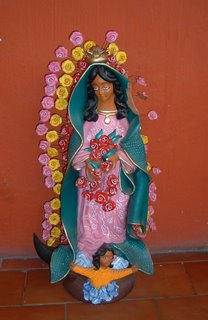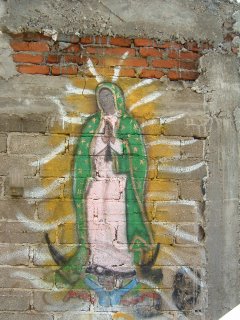
She is on taxi cabs, playgrounds, taco stands, churches, T-shirts, buses, bars, candies...and she is made from wood, tin, paper, sugar, plastic, paint and bottlecaps. I had no idea she was so affecting, and everywhere in this culture. Maybe there is no other religious symbol and ritual that is shown in so many places and so many ways as the Virgen of Guadalupe? She is a profound force; a strong ritual.
RITUAL: the general purpose is to express some fundamental truth or meaning, bring out emotional responses and engage a group of people to strengthen their common bond.
There are many rituals in our lives that give us meaning: handshaking when we meet a person is a cultural ritual, wedding ceremonies, swearing on the Bible in court, raising flags, etc. Here in Mexico, the Virgen of Guadalupe is such an interesting blend and reconciliation of European Catholic and pre-Hispanic indigenous beliefs and rituals, that gives meaning and links family, religion, politics and national/ethnic indentity. Simply, she makes her presence known...she matters alot it seems, and creates an emotional resonse for many.
Octavio Paz: "There are two beliefs deeply imbedded in Mexican consciousness; belief in the lottery and belief in the Virgen of Guadalupe."
Sandra Cisneros: " That was why I was so angry every time I saw the Virgen, my culture's role model for a brown woman like me. She was an ideal so lofty and unrealistic it was laughable. Did boys have to apsire to be Jesus?"
Bishop Oscar Romero: " Shortly after 'civilization' entered our continent, the Virgen of Guadalupe came to offer a special presence of the church, with her own unique physical presence. She was not a European woman, nor just Indian. She is the expression of MESTIZO, the new race which in that moment emerged in history. And so the brown woman will be from then on also the one who gives unique physical presence to the church on this continent."
A bit of background of " Virgen Morena" (the Dark Virgen)..Nuestra Madre (Our Mother). Ten years after the taking of Tenochitlan, today's Mexico City, by Cortez in 1521, the first fiqure in this story is an Aztec man named Cuahtlatuatzin, born in 1474. He did not belong to the Aztec social categories such as priest or merchant. He was not a slave, but was of a low position who worked the fields and weaved plant fiber mats. He was married with no children.
In 1525 he was converted to Catholicism and baptized with a name change to Juan Diego. Every Saturday before dawn, the locals said he walked the nine miles to the church in Tenochitlan for mass and religious instruction. He walked barefoot, as did all the people of his class, and in winter would wear the common robe made from the fibers of the maguey cactus.
When he was 57 yrs. old, and on an early morning walk on December 9, 1531, he was stopped by light and music. Here he saw a vision of a beautiful dark-skinned woman calling herself the Virgen Mary, mother of Jesus. She told him it was her desire to have a church built on that very spot, and go tell this to the local Bishop Juan de Zumarraga. No easy task, but finally Juan Diego got to see the Bishop. The Bishop asked for some proof of this unlikely vision. Confused and scared, Juan Diego avoided the hilltop of the vision for a few days. But on Dec. 12, while rushing to find a priest for his sick uncle, he took a shortcut across the hill. The Virgen appeared again, and Diego told her that he needed proof. So the Virgen told him to pick the roses of the usually barren hillside and put them in his robe, to take to the Bishop. Juan Diego did that, and while emptying out his robe before the Bishop and others, there was left behind on the robe the perfect image of the Dark Virgen.
The Bishop ordered a small church to be built, and by 1709 the larger Basilica of today was finished. The robe is still there on display.
Why should a form of the Virgen Mary appear to an indigenous man in recently conquered Mexico, and speak to him in Nahuatl, the Aztec language? And call herself 'Guadalupe' a Spanish name? The origin of the word is in controversy. It is thought here in Mexico that the name came about from a translation from Nahautl to Spanish. The Aztec word of 'Coatlaxopeuh', which is pronounced 'guatlasupe', sounds very close to the Spanish 'Guadalupe'. In Nahuatl, COA..meaning serpent, TLA...meaning 'the', and XOPEUH means to stamp out or crush. And in the Aztec mythology, the serpent-god Quezalcoatl was an important figure. Was the Dark Virgen here to crush the serpent? Interesting to note that in Genesis 3:15 of the Old Testament, it is said a woman would step on the serpent's head.
The Virgen was supposed to have told Juan Diego in his native language, " Let not your heart be disturbed. Do not fear sickness. Am I not here, who is your mother? Are you not under my protection? Am I not your health? Are you happy in my fold? What else do you wish? Do not grieve or be disturbed by anything."
Juan Diego lived until he was 74 yrs. old, telling of the vision. When he died on May 30, 1548 he said, " I am a nobody. I am a small rope, a tiny ladder, the tail end. A leaf ".
The imagery of the Virgen is interesting, it merges allusions from Song of Songs 6:10 " I am dark, but I am lovely"..and Revelations chapter 12, " the woman of the Apocalypse, a woman clothed with the sun ". Her face is Mexican, MESTIZO, her dress Judeo-Christian. By combining the imagery and synbolism associated with female deities such as the sun, moon and stars, the colonial image of this new Virgen gained strong importance for the native population. Rather than just purely reflecting European tradition, Guadalupe proved to be a kind, loving and accessible. The miracle was reconized by Rome in 1745.
It was the image of Guadalupe on the banners for Mexican Independence in 1810. The first President of the Republic of Mexico, Manuel Felix Fernandez, after elected changed his name to Guadalupe Victoria. In 1859, the Mexican President Benito Juarez drew up the new laws of dividing church and state, severly cutting back the power of the Catholic church, but he created Dec. 12 as a national holiday, the only religious one to remain.
In colonial times, the Virgen was interpereted as a native and submissive, forgiving mother. Today she is also reinterpreted as a symbol of liberation and action. The Virgen gives ritualistic and real meaning to many.
In Oaxaca, on Dec. 11, 12, people are in the streets and go to the Iglesia de la Virgen de Guadalupe to show tribute, ask for a miracle, or give thanks for one already received. And the usual tradition in Oaxaca is centered around children. Focused on prayers of protection and grace for them. And so, on these two days thousands of girls are dressed in costumes of the indigenous groups and the boys are dressed to look like Juan Diego. Families come with loads of roses and poinsettias to leave at the church.
All the these images, all these rituals are such an absorbing reconciliation of Catholic and pre-Hispanic beliefs. Guadalupe is a huge symbol of popular religion. A feminine metaphor for the understanding of the sacred. Complex and strong, and with a very emotive power and meaning for Mexicans.
Que milagro! Adios, Bruce




















